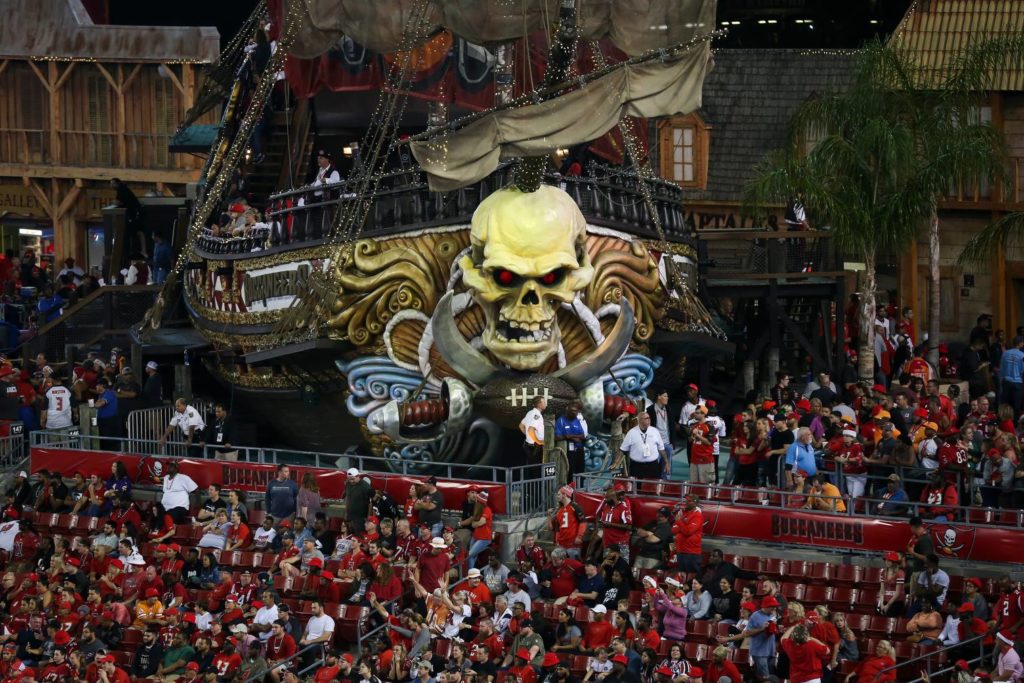When the Tampa Bay Buccaneers, the Tampa Sports Authority and Populous unveiled Raymond James Stadium in 1998, the stadium’s most distinctive feature was the 43-ton pirate ship in the north end zone. It provided a signature architectural flourish for the stadium, serving as a blueprint for future NFL facilities. Here are our favorite NFL-stadium architectural delights.
Raymond James Stadium replaced Tampa Stadium as the home of the Bucs. Tampa Stadium featured a unique look, with the two grandstands sporting a unique arch-shaped design that led to the nickname of The Big Sombrero for the facility. But the concrete utilized heavily in construction and the aluminum bleachers just sucked up the heat from the Florida sun, and it became apparent that a replacement was in order.
While much of the original design of Raymond James Stadium was pretty standard for the day, the 103-foot-long pirate ship was an audacious addition to game-day action. Replica cannons are fired when the Bucs score, enter the opponent’s red zone or win a game. Alas, fans aren’t allowed on the pirate ship—only Bucs personnel, who throw beads and other goodies from the deck. To round things out, a talking remote-control parrot interacts with the crowd. It may seem like a modest feature today, but it stood out when it was unveiled in a league that had previously favored utilitarian designs.
PHOENIX
Rising from the Glendale desert like a gigantic flying saucer, State Farm Stadium (the former University of Phoenix Stadium) can be seen for miles and miles and miles, serving as a daily visual reminder of the NFL’s Arizona Cardinals. Designed by noted architect Peter Eisenman and Populous, the steel-clad State Farm Stadium is still state of the art when it comes to NFL stadiums, with a retractable roof and a field that rolls grass outside for maximum sun exposure and then brought in for games. That flexibility allows for a slew of events, like concerts, trade shows and Final Four basketball tourneys, to be held without impacting the field whatsoever. But ask any Valley of the Sun resident, and it’s the unique exterior design that still makes State Farm Stadium a local, notable fixture.
MINNESOTA
Designed to look like a Viking ship with a bow pointing toward the heart of downtown Minneapolis, U.S. Bank Stadium combines a distinctive exterior with a technologically advanced interior. The home of the Minnesota Vikings was a welcome replacement for the Metrodome, both in terms of interior amenities and the dramatic impact on the downtown skyline, with a sharply slanted roof that is both practical (snow slides off instead of gathering) and aesthetically pleasing. Inside, the HKS design shines, literally: Five large glass doors to the west, between 75 and 90 feet high, can be rotated to allow in fresh air, while the southern half of the stadium roof is made up of transparent panels of ethylene tetrafluoroethylene (ETFE), a plastic that allows in plenty of light.
ATLANTA
It’s hard not to be awed at an Atlanta Falcons game at Mercedes-Benz Stadium, either by the scale of the 75,000-capacity stadium or the unique six-story-tall, 360-degree HD videoboard encircling the playing field some 1,075 feet around. Add in visually imposing eight-piece ETFE-based retractable roof (with each panel weighing 500 times), and the design from HOK is an architectural delight: there’s nothing like it anywhere.
JACKSONVILLE
OK, so adding pools, cabanas and plenty of HD displays may not be inspired architecture, but it certainly is inspired design. Jacksonville Jaguars owner Shahid Khan worked with Haskell Architects to transform some marginal corner areas at TIAA Bank Field into party zones—a marketing strategy that plays well among Florida millennials. Khan broadened the team’s appeal past hardcore football fans by creating a distinctive experience.
This article first appeared in the weekly Football Stadium Digest newsletter. Are you a subscriber? It’s free, and you’ll see features like this before they appear on the Web. Go here to subscribe to the Football Stadium Digest newsletter.

